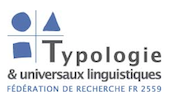PresentationLinguistic typology has contributed greatly to enriching foundational debates related to the search for linguistic universals and invariables. Are these the result of general cognitive factors, and/or of universal grammar? Typology also raises the issue of the definition of human language, by specifying a number of possible types and excluding others (Corbett). This question furthermore is extended to phenomena of linguistic variation due to diffusion, language contact, convergence and fusion (Matras). The typology of language contact implements concepts and cognitive models encompassing speaker competence and sociolinguistic motivation. It highlights hierarchy types in loans. Cognitive phenomena as they are examined by psycholinguistics and acquisition theories make up another rich field of research for understanding linguistic structure and theorizing about it. Exploring language acquisition through a typological perspective by comparing very different systems and structures raises methodological challenges regarding the characterization and comparison of the facts under discussion (Stoll). Analogous methodological challenges appear in the field of the typology and comparison of evolutionary phenomena on a large scale, and their relationship with linguistic universals (Bickel). The study of language change, particularly grammaticalization, suggests that universals can emerge from several distinct diachronic processes, which may not be motivated in terms of the principles traditionally postulated on synchronic grounds and may not be amenable to a unified explanation (Cristofaro). A fine-grained understanding of such phenomena is based on processing and analysis methods using large databases including very diverse language families. The last decade has seen the emergence of comparative, phylogenetic and statistical methods which make it possible to generalize from structured linguistic data (Hammarström). These methods take into account the variation at the heart of rhythms of change (punctual and gradual), and the influence of the environment and social context on linguistic structure. The typology of prosody (Himmelmann) and of phonology (Ridouane) is another broad field where combined approaches are necessary, for example by taking into account the interaction between phenomena of tone and pitch or intonation, and the interaction between vowel length, quantity and voice quality. The courses will showcase varied theoretical approaches and will deal with questions of syntax (Abeillé, Creissels, Chappell, Verstraete), semantics (Koptjevskaja-Tamm, Vanhove, de Hoop), pragmatics and information structure (Van Valin, Latrouite), sign language (Pfau), as well as the comparative study of conversational structure including turn-taking, repair and sequential organization (Dingemanse), and of multimodality (Gullberg). Four of the courses will focus on different languages presented from a typological perspective: Sinitic languages (Chappell), Siberian languages (Packendorf), Otomangic (Palancar) and Amazonian (Rose). |
| Online user: 1 | RSS Feed |

|

